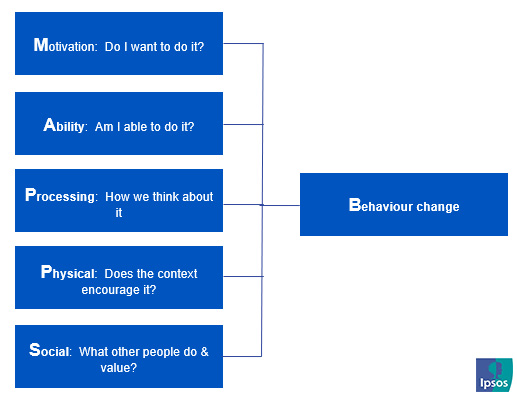How COVID-19 has brought behaviour change thinking into focus
Over the past six months, we have seen the many dramatic impacts of COVID-19 and the reverberations that it has created across society. While the future beyond the COVID-19 impact is unclear, we can more clearly see that thinking in terms of Behaviour Change is increasingly important.
Whether it was at the start of the pandemic when major shifts were required by many individuals to help curb the initial spread of COVID-19 to more recent behavioural changes that require the adoption of new behaviours or for individuals to adapt old behaviours, understanding the range of influences that shape behaviour and create lasting change is an imperative for brands and governmental bodies.
In examining the behaviour changes that have occurred or are continuing to be formed, we are seeing different profiles of the range of influences on different types of behaviour. Using our Behaviour Change Framework (MAPPS) (see below), we conducted research to examine the influence of a range of dimensions on mitigation in the maintenance of protective behaviours and re-engagement in the resumption of regular activities.

From our research it seemed that governments globally have been highly effective in encouraging people to protect themselves and mitigate against COVID-19, with an average of 82% polled saying they are comfortable following protective guidelines. By comparison, only 61% people said that they were comfortable resuming regular activities.
The table below shows how comfortable people are with re-engagement or mitigation amid the outbreak.
Using our Behaviour Change Framework to explore the different influences for these behaviours, we saw that these behaviours weren’t simply complementary to one another. Instead, a different set of influences are shaping comfort with these two behaviours – this is critically important to understand as this will mean that different strategies are needed to shape these behaviours.
What can drive re-engagement?
The most important characteristics for driving comfort with re-engagement were found to be:
- Management of outcome expectations (help people consider the risk when they are out is low)
- Self-efficacy (help people feel confident managing risk)
- Routines (help people develop new patterns of behaviour)
This shows that for brands and governments to support the resumption of activities there is a need to ensure that behavioural strategies are in place that help people functionally navigate their environments, so they feel they are managing risk effectively. Giving people measures such as an app that provides current risk assessment based on location and activity will help. Further, people need to feel confident about their ability to navigate including providing opportunities for people to try different protective equipment to learn how they feel and work. Moreover, there is also a need to help people to develop effective routines such as providing mnemonics for people to remember simple guidance when they are out.
What drives mitigation?
While there is a need to support people in their re-engagement with the economy, there remains a need to continue to encourage adherence to protective guidelines. This is the other side of the decision dilemma which requires a different approach. The key dimensions for supporting this were found to be:
- Emotion (feeling happy about following protective guidelines)
- Internalisation (having personal satisfaction to follow guidelines rather than simply doing it because it is required)
In order to ensure that people continue to adhere to guidelines, behavioural strategies need to be in place that support positive emotions such as sending “well-done” emails to people who have been in lockdown. There is also a need to facilitate internalised motivation such as introducing online groups that connect people of similar risk profile to allow them to share strategies for managing lockdowns, and this differs by country.
Together, these sets of findings highlight the importance of Behaviour Change thinking that is informed by behavioural science to explore the range of influences that are shaping a specific behaviour. Managing these changes is one of the biggest challenges facing brands and governmental organisations – as we move to less predictable, unstable environments, individuals are increasingly navigating change. But by applying Behaviour Change thinking it not only provides an effective diagnosis of behaviour, it also can be used to provide linkage through to intervention activities to help support the various behavioural changes needed as individuals adapt to COVID-19 now and the other disruptions we will undoubtedly face in the future.

![[Webinar] KEYS: THE MIDDLE CLASS: In Crisis?](/sites/default/files/styles/list_item_image/public/ct/event/2025-10/middle-class-family-dinner-food-carousel.webp?itok=iD1QyX8n)
![[Webinar] KEYS: Global Trends - The Uneasy Decade](/sites/default/files/styles/list_item_image/public/2025-09/image/minisite/keys0925.png?itok=3oAiYcxm)
